Travel agencies serve as intermediaries between travel products suppliers who want to expand their customer reach and travelers who want to see what their options are and book a number of travel services from one convenient interface. To make it possible, a travel business has to have access to multiple suppliers and present the most up-to-date travel information such as current availability, rates, and so on.
Today, there are multiple sources of such information from different travel market players – on different conditions. So, to help travel businesses make an informed choice, we’ll describe where and how travel inventory can be sourced and what its main management aspects are.
Travel agency inventory basics
In this article, we’ll mainly talk about the online travel agency (OTA) businesses and their operational model. But let’s quickly recap the nuts and bolts before we proceed with the where and how.
What is travel inventory?
Travel agency inventory includes any travel-related products sold by their providers or distributors such as wholesalers, travel agencies, or tour operators. Travel inventory can include
- flights,
- lodging (hotel rooms, apartments, vacation rentals, or any other kind of accommodation),
- car rentals,
- cruises,
- tours and activities, and
- other kinds of transportation, e.g., rail or bus tickets.
While the word inventory suggests that travel agencies own these products and store them internally, in reality, it’s not always the case. More often than not, travel agency systems act as aggregators and mediators to source travel products and content from supplier reservation systems that act as the source of truth. For instance, if you sell flights, current seat availability will be stored in the airline's reservation system, because this airline distributes flights across many resellers and… well, knows which seats are already booked and which are available.
Other types of information, such as hotel room descriptions, photos, and airline logos can be kept internally in the OTA’s database since they don’t change that often. This leads us to the major concepts of dynamic and static content.
What are static and dynamic travel content?
Dynamic content is the type that constantly changes, such as availability and rates. Agencies normally don’t store dynamic content but rather access it in suppliers’ systems via APIs every time a traveler searches for flights or accommodation for their destinations and dates (caching is also an option, but we’ll talk about it later).
Static travel content, as we said, is the one that doesn’t change often, e.g., descriptions, pictures, seat maps, hotel amenities, and so on. Such content is usually stored in the OTA’s database, so instead of requesting it every time a traveler makes a query, agencies either purchase this information separately or pull it via an API and store it for further use.
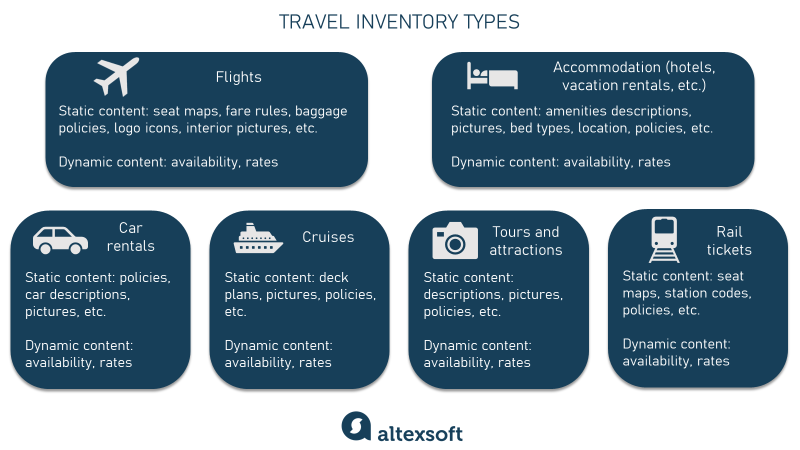
Types of travel inventory and content
Where do OTAs get their inventory?
This is a foundational problem a travel agency must solve to successfully operate. Suppliers, their types, and underlying contracts define revenue management, technology, and a business niche that the agency targets.
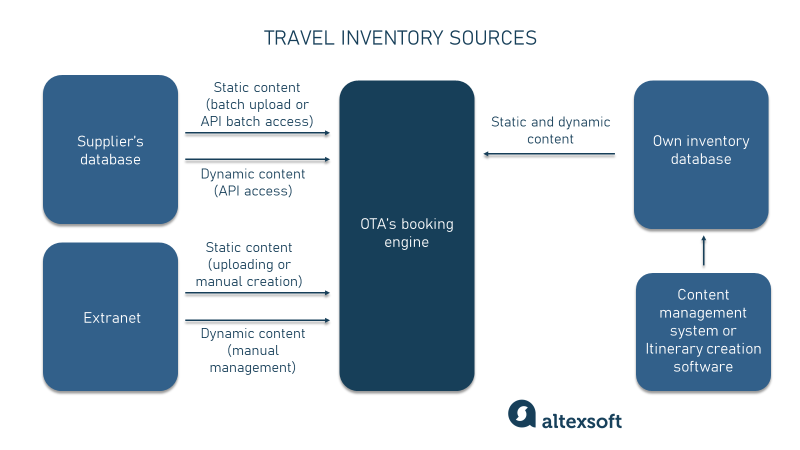
How and where OTAs source inventory
Direct supply and integrations
If you want to sell the rooms of a hotel next door, you can pay them a visit, sign a contract, and integrate directly with their property management system (PMS) and channel manager. In this case, when you have a query from your customers, you’ll be able to pull this hotel rooms’ description, availability, and rates right from its system. If your customer wants to book the room, this two-way integration will let you automatically transfer the reservation details to the hotel PMS.
The drawbacks of this approach are obvious though: Building separate integrations is just too costly, lengthy, and complicated overall, so it might only work for small OTAs in niche markets or for specific inventory beside the main business focus (for example, if you want to integrate with a local car rental company).
On top of that, some suppliers, such as airlines, wouldn't be willing to integrate directly with just any agency that knocks on their door. For this reason, OTAs have to deal with aggregators and other middlemen.
Aggregators and other middlemen
That said, OTAs turn to different intermediaries – depending on the type of inventory needed. Middlemen, such as global distribution systems or wholesalers, are B2B businesses specializing in aggregating access to a large number of end suppliers (e.g., hotels or airlines) and reselling this access to distributors. This approach entails two scenarios.
Integrating and contracting middlemen. You, as an OTA, apply for partnership with a middleman company, sign an agreement that defines commission rates and other cooperation conditions. Then you enable a two-way system integration via APIs to automatically obtain inventory details upon request and send booking information in case a customer wants to make a reservation.
This is arguably the simplest approach as agencies have to deal with a single entity both in terms of integrations and contracts. But it’s also the least lucrative one, as you don’t negotiate directly with the end supplier to get better rates.
Integrating with middlemen and contracting a supplier. The smart path is to integrate with middlemen on the technology side, but also have direct agreements with a handful of critical suppliers. For example, if your niche is to sell cross-Atlantic flights with a stopover in Iceland, you can enable search and booking via GDS but also have a direct contract with Icelandair to get better rates.
Extranet
One of the rare scenarios, more common for large OTAs, is to develop an extranet. This is an internal system on the agency side that allows end suppliers to manually upload and edit their static content and manage the dynamic one. Some OTAs create robust, multifunctional extranets with not only content management functionality, but also marketing campaigns support, reporting options, and more.
The drawbacks of this approach: Larger suppliers willing to work with many distribution channels don’t deal with manual extranet management. And small ones, if they stick to a single distributor, are likely to choose the largest ones with the broadest market. So, the scenario where a mom-and-pop hostel lists property on Booking.com is realistic, while Hilton managing their inventory at mom_and_pop.com's extranet, not so much. On the other hand, small local suppliers with small local distributors is still possible.
Own inventory
If an OTA owns, say, a hotel chain, inventory is sourced directly from the hotel’s PMS, which is connected to the OTA software, so no intermediaries are needed. It’s the same story about OTAs operating their own airlines or car rental companies.
A similar case is when tour operators create their own packages or travel products, for example, city tours. Such inventory is stored in their own database, including all the related information such as descriptions, rates, schedule, and so on.
To learn about specialized tour operator software, see our dedicated article.
Contracted inventory
Another common scenario for tour operators is acquiring allotments, or buying inventory in bulk and then combining them in packages. In this situation, they also store all the inventory information in-house. Typically, end suppliers are manually informed about upcoming reservations, e.g., getting a list of travelers and related details via email.
Okay, now that we have an idea of where inventory can come from, let’s talk about how we can manage it efficiently.
OTA inventory management: main aspects
An OTA’s back office is a complicated, multi-component system with inventory management being one of its operational segments aimed at sourcing inventory and managing content. Let’s look at this process in more detail.
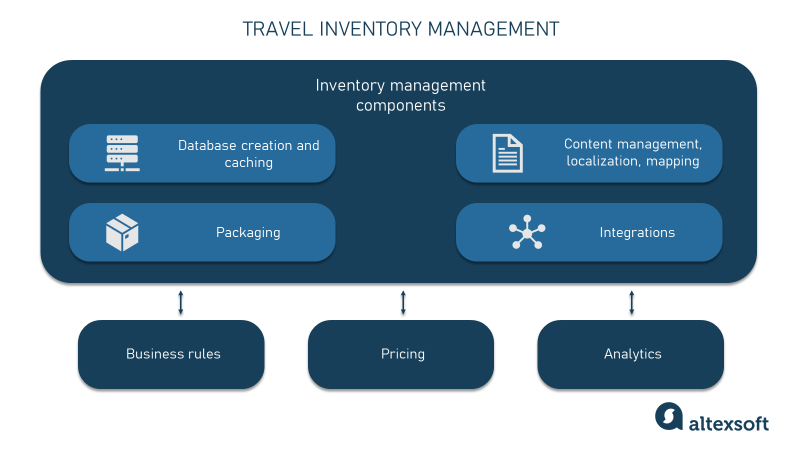
Main inventory management aspects and related modules
Creating an inventory database and caching
As we’ve described above, there are several inventory sourcing scenarios. Logically, they have to be technically implemented in different ways.
Dynamic content. If you sell your own inventory, it’s stored in your internal system where you manage availability and rates and where you easily fetch it from in response to customer queries. A similar situation is selling allotments or contracted inventory that you upload and manage within your internal database.
If you get dynamic content from a middleman or inventory supplier directly, in most cases, you’ll have to create an API integration. However, many inventory providers charge a fee per API transaction, so if you have a busy agency with many requests, it might cost an arm and a leg. Instead, consider developing a caching system that will store the latest search results and only update information once in a while.
Static content. As we said, you can create an extranet where your suppliers will create and manage their static content (and often dynamic too), but a more common situation is purchasing it in sets (like lists of airports, airline icons, or hotel descriptions) from specialized providers. In any case, it’s stored in your system and presented to customers upon request.
Content management, localization, and mapping
If you create your own inventory, it’s vital to present it right so that travelers want to buy from you instead of your competitors (check our article on OTA marketing for more tips on how to work with your customers). So, travel agencies and tour operators often implement a content management system that helps create attractive descriptions, add imagery, play with fonts, colors, and layouts, and do other design magic.
Whether you sell your own or purchased inventory, you have to remember that you deal with multinational customers, so offering translated and adapted content is another effective way to stand out and present more value. Learn more about localization aspects and best practices in our detailed explainer.
It also might happen that you get the same inventory from multiple different suppliers. It especially concerns hotels, hotel rooms, and their descriptions. The same property may have slightly different content and descriptions, depending on a supplier as each has their own naming conventions.
This leads to travelers seeing the same room twice (or more!) in their search results with different descriptions. To tackle this problem, you either have to turn to a hotel mapping provider for higher-quality content or map it yourself. Read more on the topic in our hotel mapping post to know your options.
Packaging
Most OTAs don’t just resell inventory, but they also offer packages of travel products at discounted prices. There are two approaches:
- static packaging (like tour operators do when they devise a tour with unchangeable itinerary and other elements) or
- dynamic packaging (when travelers can choose the package components themselves).
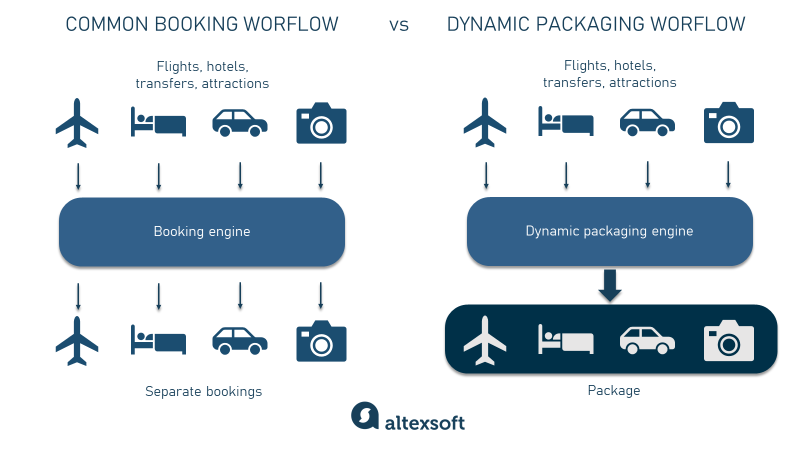
Dynamic packaging engine vs traditional booking engine
Such functionality requires specialized technology solutions and a set of business rules that regulate the process and make it convenient for a customer and profitable for you.
Integrations
We’re talking about external integrations a lot in this post (and we'll talk more) so you’ve probably already realized how important seamless connections are. However, you also have to remember about establishing smooth data exchange with your internal systems (such as a pricing module, booking engine, accounting tool, etc.) so that all your IT architecture functions efficiently with no data leakages and minimal human intervention.
Related modules: business rules, pricing, and analytics
There are three other aspects worth mentioning that are closely interconnected to inventory management, but are technically parts of other modules.
Business rules. It’s important to set up business rules that determine the search priority for supplier networks (depending on agreed rates and other cooperation conditions). A system of well-thought-out business rules defines all the logic behind running OTA activities, from supplier connections to packaging to cancellation policies. For instance, if you can find the same property from two different suppliers, you want to show the one that suggests better net rates for you, according to your contract.
Pricing. Setting prices is a crucial part of revenue management. OTAs earn their money by adding markups and charging commissions, so configuring a suite of business rules that regulates the pricing of the agency’s inventory is a task of paramount importance. Read more about revenue management and dynamic pricing in our dedicated articles.
Analytics. The importance of information and analytics in today’s world can’t be overstated. Inventory management activities generate tons of valuable data that has to be carefully analyzed to obtain fuller visibility into the agency’s activities, evaluate performance (of suppliers, channels, inventory groups, etc.), define trends, and make effective strategic decisions. Read more about OTA analytics in a dedicated post.
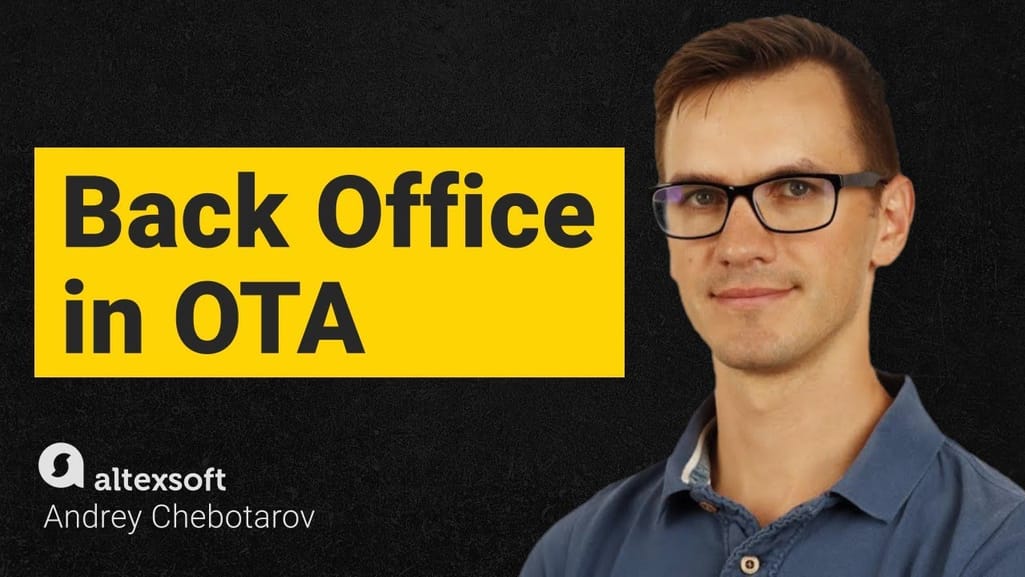

Watch a video with our travel technology expert to get a fuller picture of an OTA’s back office
Okay, so now that we’ve described the main sources of OTAs inventory and key management elements, we’ll dive deeper into the options of partnering with different intermediaries and aggregators since that’s the most common inventory sourcing scenario.
Note, that here we are going to focus on describing the general operational concept. If you need specific connectivity details and documentation, please visit our detailed overview of the main travel APIs in a dedicated post as well as other linked articles throughout the text.


A short video about what API connectivity in travel is about
Okay, no more chit chat, let’s finally get to the nitty-gritty. So, where should you be looking for flight inventory?
Flights inventory
Travelers often turn to travel agents instead of airline websites to compare options, get better deals, or book several flights from different airlines in one place. Since most flight-related content is dynamic, OTAs have to source it in real time. Here’s where they take it from.
GDSs: industry behemoths
Global distribution systems or GDSs (with Sabre, Amadeus, and Travelport having the leading roles in this play) are large marketplaces originally created by airlines to distribute flight inventory. Though today, travel agents turn to them for a wider range of travel products.
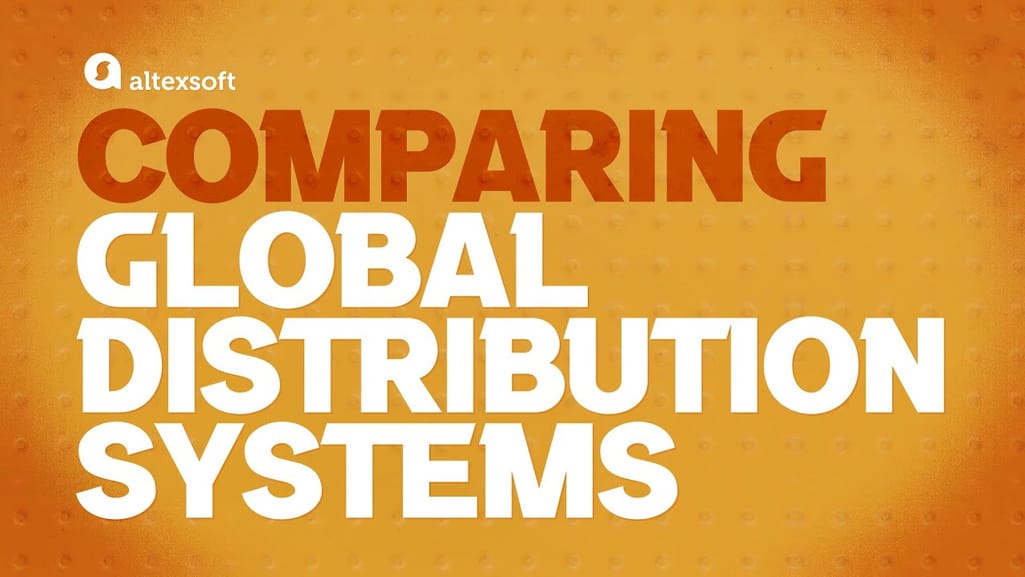

Check our video comparing the biggest GDSs
GDSs are actually the main source of information about current flight schedules, availability, and rates, so agents can book flights and even some ancillaries from more than 400 airlines in one place. In practice, an OTA that integrates with GDSs strives to negotiate direct agreements with critical airlines to get special rates.
As for static content, there isn’t much of it when we talk about flights. You can obtain seat maps from GDSs (check Sabre’s seat map API as an example), but if you want to get more, e.g., airline logos or interior photos, you’ll have to look for third party-providers.
Key players: Sabre, Amadeus, Travelport
What you can get: rates, availability, schedules, seat maps, booking capabilities
Pros: GDSs are the main source of flight data from 400+ airlines
Cons: limited static content, complicated integration process (read a real story of our Sabre integration experience to get an idea of the challenge)
NDC: new standard trying to replace GDSs
New Distribution Capability or NDC is actually a data exchange format aimed at replacing the older, clunky EDIFACT protocol typical for GDSs with a new XML standard and enabling direct connections between distributors and airlines. Its adoption started back in 2012 and is ongoing.
Airlines represented by IATA were the masterminds behind the NDC initiative as they are the ones that benefit most from its adoption, avoiding high GDS booking fees and getting hold of travelers data. So, some of them even incentivize OTAs to connect directly via NDC.
NDC enabled sharing rich content (e.g., descriptions and aircraft images) and made it possible to purchase more ancillaries, such as extra bag allowances, onboard WiFi, etc. And all that sounds great, but to source content, OTAs have to connect to each airline separately – which isn’t a piece of cake. A solution to that can be connecting to an NDC aggregator such as SITA or Farelogix (now Accelya) that’s already integrated with multiple airlines.
Lately, NDC starts being available via GDSs themselves but its adoption is still slow and not all airlines are available. In addition, booking capabilities for agents are still underdeveloped.
Key players: SITA, Farelogix (Accelya), Lufthansa, British Airways, United Airlines, American Airlines, Air Canada
What you can get: full static and dynamic content, booking capabilities
Pros: incentives from some airlines, modern connection, rich content
Cons: fewer inventory providers, necessity to integrate separately with each supplier
Consolidators: air market wholesalers
Flight consolidators are entities that have access to airlines’ unpublished, private fares (discounts range from 30 to 60 percent off retail prices), so they can offer cut-rate inventory to travel agents – with a markup, of course, but still at a more appealing price. The catch here is in the word “unpublished”: These fares can’t be publicly listed anywhere. They can be foggily advertised, sold as part of a package, or shared, say, over the phone, so travel agents have to be extra careful when handling these figures.
Since wholesalers usually have contracts with major GDSs, OTAs that have agreements with consolidators can use their credentials to have access to inventory (and contracted rates) from a GDS. You still need a contract with a GDS to buy inventory, even through another entity.
Moreover, big OTAs often have several agreements with different consolidators so that they can choose the best fare when looking for rate options. On the other hand, discounted inventory from consolidators can be reached through GDSs.
Another advantage is that if an OTA doesn’t have IATA and other accreditations needed for issuing air tickets, consolidators can ticket their bookings, no matter where they are purchased.
Key players: Mondee, Picasso Travel, Centrav, GTT Global, Downtown Travel
What you can get: rates, availability, limited static content like fare rules and seat maps (depends on the consolidator), booking capabilities
Pros: access to multiple GDSs and airlines, cheaper rates, they can ticket your bookings (if needed)
Cons: consolidator inventory is often nonrefundable, private fares can’t be published
Metasearch sites and big OTAs: working with competitors
Getting inventory from your competitors can be a viable option for small OTAs that are just starting off and, for example, can’t afford connecting to GDSs, or the ones that offer specialized services at some niche market with flight sales being a sideline. Imagine a tour operator who takes groups to visit authentic tribes of Papua New Guinea – they might only want to help their customers find flights to a specific destination and get an affiliate commission.
Basically, if you become a partner of metasearch platforms, you can get basic flight information (some also provide static content such as fare rules or baggage policies); to book a seat, you’ll be redirected to the supplier’s website. Meanwhile, OTAs such as Kiwi allow for booking through their own interface.
Key players: Skyscanner, Kiwi, Kayak, Google Flights
What you can get: rates, availability, limited static content (depends on the platform)
Pros: easy way to earn affiliate commissions, easy integration
Cons: no discounted rates, no booking capabilities through metasearch, vetting required to become a partner
To read more about airline distribution and get a bunch of useful flight booking API links, check our related post. And now we’re moving on to accommodation inventory.
Hotel, vacation rental, and other lodging inventory
Some OTAs specialize in hotels, while others focus on diverse types of alternative lodging. Let’s look at the main sources of such inventory.
GDSs: a one-stop-shop
Same old GDSs, as we said, can also serve as a source of hotel inventory. It can be a good option for OTAs that sell a range of travel products (and can source them all in one place) or travel management companies that handle corporate travel and are just traditionally dealing with GDSs mostly.
Otherwise, connecting to GDSs isn’t the best idea as they can’t boast of great customer support, easy integration, or rich static content.
Key players: Sabre, Amadeus, Travelport
What you can get: rates, availability, limited static content, booking capabilities
Pros: access to diverse inventory
Cons: expensive, mediocre static content, no vacation rentals, complicated integration, inventory focused on business travel and somewhat lacking properties that target leisure clients
Wholesalers: decent value for money
Wholesalers or bed banks buy rooms at bulk (at discounted rates, of course) and resell them to OTAs. Some big ones are Hotelbeds, WebBeds, or HotelsPro. They’re usually the main source of inventory for agencies since they typically offer decent rates, coverage (including vacation rentals), and connectivity. They also provide static hotel content which is a nice complement to other perks.
Key players: Hotelbeds, WebBeds, HPro Travel (formerly HotelsPro)
What you can get: both static and dynamic content, booking capabilities
Pros: rich content, access to vacation rentals inventory, modern integration capabilities, no direct contracts with hotels needed
Cons: large bed banks might not have enough inventory to cover the whole market, so if you need wide coverage for a specific niche, you need some local wholesaler or destination management company
Channel managers: tech providers on the hotel side
Channel managers are handy pieces of software that hotels use to distribute their inventory across multiple channels. Essentially, they are tech providers that work with hotels or vacation rentals directly, so if you connect to them, it might pave the way for close partnership with no extra middlemen and piling-on commissions.
It would’ve been a great option if there wasn’t a but... Channel managers earn money from hotels so they want to connect to them, not another OTA. So, you might have to become a big player first so that hotels and channel managers want to add you as a distribution channel. Though you can negotiate with a hotel brand so that they vouch for you to be added to the channel manager.
Another downside is that channel managers are just a tech interlayer, and to be able to sell a hotel’s inventory, you have to have an agreement with it. Oh, and many of them don’t deal with static content either.
Key players: SiteMinder, Cloudbeds, RezGain, eZee
What you can get: rates, availability, booking capabilities
Pros: channel managers don’t charge for integrations and booking, modern APIs
Cons: channel managers might not be interested in connecting, agreements with hotels needed, limited or no static content
Bigger OTAs: working from under the older sibling's wing
Such major players as Expedia or Booking.com readily source their lodging inventory to their competitors – for a commission, you know. And compared to wholesalers, their hotel coverage is usually much bigger (say, Hotelbeds works with 300k hotels, HPro Travel claims to have a portfolio of 1 million properties, but Booking.com offers over 2.5 million accommodation options).
Even though such a business model will bring you access to abundant inventory and rich content, you have to remember that when you sell another OTA’s inventory, you’ll have to split the commission, so crunch the numbers to see if that shared profitability works for you.
Key players: Expedia Group (including Expedia, Vrbo, Travelocity, etc.) and Booking Holdings (including Booking.com, Priceline, Agoda, etc.)
What you can get: static and dynamic content, booking capabilities
Pros: huge inventory supply, convenient connectivity, rich content
Cons: lower profitability because commissions have to be shared
Hospitality marketplaces: innovative distribution 2.0
Hospitality marketplaces have evolved in recent years as hubs that connect accommodation inventory providers and resellers. Since extra intermediaries are bypassed, OTAs can get better rates and rich content with no need for direct contracts with separate hotels. Plus, these platforms have developed solid, modern APIs for convenient integration.
Key players: Impala, Katanox, HyperGuest
What you can get: full static and dynamic content, booking capabilities
Pros: low rates, convenient operation, modern APIs, rich content
Cons: since these platforms are just starting-off, their inventory supply is still limited
API aggregators and content providers: connectivity and mapping
Building integrations is always a pain in the neck, no matter how well-written API documentation is. So if you want to avoid the hassle but still connect to multiple suppliers, you can integrate with a single aggregator and enjoy access to its pool of suppliers. Yet this also comes with a catch, because aggregators will support you with a single integration point, but you still need direct contracts with their suppliers to source inventory.
Some aggregators also provide mapping services (remember, we mentioned this process – merging pieces of content from different suppliers to avoid duplications and inconsistencies), so we’ve also added content providers to this group. Sharing and mapping static content is an important aspect of the hospitality distribution system. So, most OTAs that work with multiple inventory suppliers, turn to mapping specialists to organize their content and avoid discrepancies anyway.
Key players: RateGain (Dhisco Switch), DerbySoft, MakCorps, TravelgateX, Travolutionary (Gimmonix)
What you can get: static and dynamic content, mapping, booking capabilities
Pros: easy integration, content mapping
Cons: extra charges for their services (usually based on the number of requests made through them), need for direct contracts with suppliers
For more technical details, you can check our post about main hotel APIs, while we continue with other inventory types.
Other types of inventory: car rentals, cruises, rail tickets, activities
The meal ticket for the majority of OTAs is selling flights and rooms. All the rest of the offerings typically just come along for customer convenience. However, you still need to source that inventory somehow. So, let’s run through your options.
Car rental inventory
A lot of travelers prefer to rent a car at their destination and have complete freedom of movement. So, OTAs offer car rental options to satisfy their customer demand. Here are main sources of this type of inventory.
GDSs. These travel industry giants deal with car rentals as well, though the drawbacks of connecting to them stay the same: high prices, integration complexity, and outdated APIs.
Tech service providers. These guys specialize in tech solutions on the B2B market, but they also offer a decent inventory supply, better pricing conditions, and integration-friendly APIs. CarTrawler, Travelopro, Trawex, and eTravos are some of the companies that belong to this category.
OTAs and aggregators. Another type of middlemen, such big OTAs and aggregators as Skyscanner, Priceline, Auto Europe, or Discover Cars are a big distribution channel for car rental companies, so they can provide access to rich inventory. Most of them have a number of connectivity options, e.g., APIs, white label solutions, affiliate programs, etc.
You can learn more about car rental APIs in a separate post.
Cruise inventory
The cruise market is smaller and a lot more reserved than that of flights, accommodation, or even car rentals. However, you still have options regarding where you can acquire cruise inventory.
GDSs. Yes, these folks took over all the major segments of the travel market. Some of them do offer cruise-related APIs, but before jumping in, check what exactly you’ll be able to do as there might be pitfalls. For example, Amadeus Cruise Portal gives access to “34 bookable and 100+ searchable cruise lines,” while Travelport provides cruise booking opportunities only to travel agents who request direct booking via a web-based platform with no APIs available.
Aggregators. There are quite a few aggregators of cruise content on the market, e.g., Revelex, Traveltek, IST, Juniper, CruiseHost, FlightsLogic, etc. After integration, you can search and book inventory from dozens of cruise lines, as well as get access to their static content (deck plans, photos, etc.). Pricing is mainly subscription-based (some also charge a transaction fee), and usually depends on the transaction volume and scope of customization needed.
Rail inventory
Old-fashioned, unwieldy railways are lagging behind the rest of the travel industry in terms of digitization, but still moving forward, slowly but steadily. If you want to enable your customers to search and book train tickets from your website, here’s where you can get them from.
GDSs. Again. APIs from major GDSs will let you obtain both dynamic (availability, rates, etc.) and static (depending on the GDS it can be seat maps, station codes, policies, etc.) content, as well as enable ticketing and ancillary sales. Other services available vary across providers: E.g., Travelport allows for loyalty card usage while booking, while Amadeus lets travelers choose aisle or window seats.
Aggregators and OTAs. Well, same old story here: Instead of archaic GDSs, you can go with a provider that has a similar number of suppliers, but offers better support, high-quality information, and fewer integration efforts. Some companies worth mentioning here are Trainline, Omio, Trawex, and TravelFusion Rail.
We have an entire article solely dedicated to rail booking APIs if you want to know more.
Tours, attractions, and activities inventory
The tours and attractions (T&A) landscape is wide and diverse with tons of providers who sell anything from traditional excursions and packaged tours to exotic, niche experiences. If you want to get hold of rich, varied inventory to satisfy even the pickiest customers, connect to the specialized reseller that partners with multiple suppliers and shares information as well as enables booking.
You typically have two main integration options: becoming a partner or affiliate (some platforms offer both). The difference between the two lies in payment – in the first case you’ll have the full booking power and process all the transactions, becoming the merchant of record; in the second case, you receive the search results, but redirect the user to the supplier’s site for booking and payment.
Some of the biggest T&A aggregators are Viator, GetYourGuide, Bokun, Musement, and Ticketmaster. Integrating with them will allow you to embed the T&A searching and booking (if you choose to) functionality into your own product.
Inventory management technology
Nowadays, it’s as plain as day that technology is absolutely essential for efficiently managing business operations. All these integrations, online presence, and smart analytics are just impossible without focused IT solutions. Now the question is – where to get them?
Well, if you expect a simple answer, sorry, there isn't one. Certainly, there are software providers that create comprehensive platforms for OTAs or separate inventory management modules (as an example, check Amadeus or GP Solutions), but you have to realize that you’ll still have to tailor and fine-tune such products so that they meet your needs.
By way of illustration, check a case study of how we at AltexSoft created an inventory management module to address the unique challenges of our client.
To seamlessly fit into your operational workflow and cover all your business necessities, consider designing a custom inventory management system with all the right integrations and capabilities that will enhance your OTA’s performance, streamline operations, and contribute to your business development and success.

Maria is a curious researcher, passionate about discovering how technologies change the world. She started her career in logistics but has dedicated the last five years to exploring travel tech, large travel businesses, and product management best practices.
Want to write an article for our blog? Read our requirements and guidelines to become a contributor.

